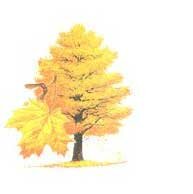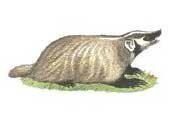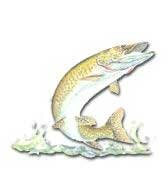Wisconsin State Symbols
Coat of Arms
The coat of arms, described in Section 1.07 of the statutes, is an integral part of the state seal and also appears on the state flag. Its history parallels that of the seal.
The coat of arms contains a sailor with a coil of rope and a "yeoman" (usually considered a miner) with a pick, who jointly represent labor on water and land. These 2 figures support a quartered shield with symbols for agriculture (plow), mining (pick and shovel), manufacturing (arm and hammer) and navigation (anchor). Centered on the shield is a small U.S. coat of arms and the U.S. motto, "E pluribus unum" ("one out of many" referring to the union of U.S. states), to symbolize Wisconsin's loyalty to the Union. At the base, a cornucopia, or horn of plenty, stands for prosperity and abundance, while a pyramid of 13 lead ingots represents mineral wealth and the 13 original United States. Centered over the shield is a badger, the state animal, and the state motto "Forward" appears on a banner above the badger.
Flag
The legislature first provided an official design
for Wisconsin's state flag in 1863, when Civil War regiments (groups of soldiers) in the field were requesting flags.
In 1913 the flag was designed with a dark blue background with the state coat of arms centered on each side. The flag did not change until 1979, when the word "Wisconsin" and the statehood date "1848" was added in white letters.
Motto
"Forward." The motto, "Forward", was introduced in the 1851 revision of the state seal and coat of arms. Governor Dewey had asked University of Wisconsin Chancellor John H. Lathrop to design a new seal. It is alleged the motto was selected during a chance meeting between Governor Dewey and Edward Ryan (later chief justice of the Wisconsin Supreme Court) when
The coat of arms, described in Section 1.07 of the statutes, is an integral part of the state seal and also appears on the state flag. Its history parallels that of the seal.
The coat of arms contains a sailor with a coil of rope and a "yeoman" (usually considered a miner) with a pick, who jointly represent labor on water and land. These 2 figures support a quartered shield with symbols for agriculture (plow), mining (pick and shovel), manufacturing (arm and hammer) and navigation (anchor). Centered on the shield is a small U.S. coat of arms and the U.S. motto, "E pluribus unum" ("one out of many" referring to the union of U.S. states), to symbolize Wisconsin's loyalty to the Union. At the base, a cornucopia, or horn of plenty, stands for prosperity and abundance, while a pyramid of 13 lead ingots represents mineral wealth and the 13 original United States. Centered over the shield is a badger, the state animal, and the state motto "Forward" appears on a banner above the badger.
Flag
The legislature first provided an official design
for Wisconsin's state flag in 1863, when Civil War regiments (groups of soldiers) in the field were requesting flags.
In 1913 the flag was designed with a dark blue background with the state coat of arms centered on each side. The flag did not change until 1979, when the word "Wisconsin" and the statehood date "1848" was added in white letters.
Motto
"Forward." The motto, "Forward", was introduced in the 1851 revision of the state seal and coat of arms. Governor Dewey had asked University of Wisconsin Chancellor John H. Lathrop to design a new seal. It is alleged the motto was selected during a chance meeting between Governor Dewey and Edward Ryan (later chief justice of the Wisconsin Supreme Court) when

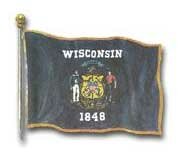

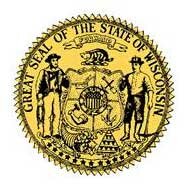
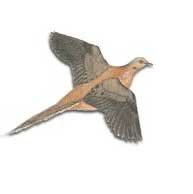
the governor went to New York City, carrying the Lathrop design to the engraver. Ryan objected to Latin motto, "Excelsior", which Lathrop proposed. According to tradition, Dewey and Ryan sat down on the steps of a Wall Street bank, designed a new seal and chose "Forward" on the spot. It is officially recognized in Section 1.07 of the statutes.
Seal
The state seal, created in 1881 after several earlier design changes, includes the state coat of arms, which also appears on the state flag. Many symbols make up the the coat of arms. It contains a sailor with a coil of rope and a "yeoman" (usually considered a miner) with a pick. These two men represent work on water and land. Between them is a shield with symbols for agriculture (plow), mining (pick and shovel), manufacturing (arm and hammer), and navigation (anchor). The small U.S. coat of arms and the U.S. motto, "E pluribus unum" ("one out of many," referring to the union of the states), centered on the shield symbolizes Wisconsin's loyalty to the Union. At the base, a cornucopia, or horn of plenty, stands for prosperity and abundance. A pyramid of thirteen lead bars represents both the mineral wealth of Wisconsin and the original United States. Centered over the shield is a badger, the state animal, and the state motto, "Forward," appears on a banner above the badger.
State Symbol of Peace
People and organizations involved in wildlife conservation worked more than ten years to protect the mourning dove. In 1971, when the mourning dove became Wisconsin's official symbol of peace, it was no longer hunted as a game bird.
State Song
In 1909, William T. Purdy composed the music for our state song, "On, Wisconsin!"Then he and Carl Beck wrote the lyrics. Beck asked Purdy to dedicate the song to the University of Wisconsin football team. In 1913, J.S. Hubbard and Judge Charles D. Rosa wrote lyrics more in keeping with the idea of a state, rather than a football, song. In 1959, "On, Wisconsin!" became the official state song.
On, Wisconsin!
"On, Wisconsin! On, Wisconsin!
Grand old badger state!
We, thy loyal sons and daughters,
Hail thee, good and great.
On, Wisconsin! On, Wisconsin!
Champion of the right,
"Forward", our motto
God will give thee might!"
Composed:William T. Purdy
Written:J.S. Hubbard and Charles D. Rosa
State Dance
A second grade class from Charles Lindbergh Elementary School in Madison requested that the polka become the state dance. Supporters from several groups, including the Wisconsin Polka Boosters, Inc. and the Wisconsin Folk Museum, believed that making the polka the official state dance would demonstrate its importance as a major Wisconsin cultural tradition. In 1993, legislators made the polka became the most recent official state symbol.
State Tree
In 1890, Wisconsin school children voted the sugar maple as their favorite state tree. In 1948, the Youth Centennial Committee organized another vote among school children. The following year, the sugar maple was named the official state tree.
State Bird
In 1926-27, Wisconsin school children voted to select a state bird, and the robin was the overwhelming favorite. It became official in 1949.
State Animals
Wisconsin's unofficial nickname as the "Badger State" occurred many years before the badger become the official state animal. During the lead-mining boom in the early 1800s in southwestern Wisconsin, miners were too busy digging the "gray gold" to build houses. Like badgers, they moved into abandoned mine shafts for shelter. The nickname stuck, and it became a fitting description of the hardworking and energetic settlers of the Wisconsin Territory.
Over the years the badger appeared officially in the coat of arms, the seal, the flag, the state song ("Grand old badger state!"), and as an architectural detail in the state capitol. "Bucky Badger" also has served for years as the mascot of the UW-Madison. In 1957, four Jefferson County elementary school children requested the state legislature to make the badger the state animal, but some people in northern Wisconsin disagreed. They wanted the white-tailed deer named the state animal. They felt that Wisconsin's large white-tail deer population and annual deer hunting season made the deer an important part of our economy and recreation. The legislature compromised by making two official animals. In 1957, it named the badger the "state animal", and the white-tailed deer as the state "wild-life animal".
In 1971, legislators added the dairy cow as Wisconsin's official "domestic animal," in recognition of the animal's importance in the state's role as "America's Dairyland".
State Beverage
Because of Wisconsin's place as the nation's leading milk-producing state Milk was chosen in 1987 as the state beverage. The World Dairy Expo and various Wisconsin dairy production and dairy cattle associations supported the action.
State Dog
After many years of effort by eighth grade students of Lyle Brumm at Washington Junior High School in New London, in 1985 the American water spaniel became the official state dog. Of the five dog breeds original to the United States, it is the only breed that comes from Wisconsin. An outstanding hunter, watchdog, and family pet, the American water spaniel is a medium-size dog with an oily coat of dark chocolate colored hair.
State Fish
As early as 1939, supporters favored naming the muskellunge or "muskie" as the official or state fish. In 1955, the legislator made the muskie the "ofFISHial" fish symbol.
State Flower
In 1908, Wisconsin school children nominated four candidates for state flower: the violet, wild rose, trailing arbutus and white water lily. On Arbor Day 1909, school children selected the violet the winner, but it did not become the official state flower until 1949.
State Fossil
Trilobites (try-lo-bites), extinct marine animals, lived hundreds of millions of years ago in the warm, shallow salt water sea then covering the area that became Wisconsin. The fossils average 1 to 2 inches in length, and its major rival in being recognized as the state fossil was the mastodon, a huge and extinct relative of the elephant. In 1985, the little trilobite won.
State Grain
Corn became the official grain of Wisconsin in 1989. Grown as a food for people and farm animals, corn is also used in making sweeteners, ethanol fuel, and biodegradable plastics.
State Insect
A third grade class of Holy Family School in Marinette and the Wisconsin Honey Producers Association requested that the honey bee become the official state insect. Others nominated the monarch butterfly, dragonfly, ladybug and mosquito. The honey bee became our official state insect in 1977.
State Soil
Wisconsin has more than five hundred major soil types. Named for a Wisconsin community, Antigo silt loam was selected in 1983 as the official state soil. This soil is of glacial origin, which means it is enriched by organic matter from prehistoric forests. It is found mainly in Wisconsin and stretches in patches across the north central part of the state. Antigo silt loam supports dairy farming, potato growing, and timber.
State Mineral & Rock
The Kenosha Gem and Mineral Society requested that galena (lead ore) be named the state mineral and red granite be named the state rock. Both are natural features of Wisconsin's environment. Because people mined galena and quarried red granite for hundreds of years, these substances played important roles in our history and economy. In 1957, the legislature made them official symbols.
Seal
The state seal, created in 1881 after several earlier design changes, includes the state coat of arms, which also appears on the state flag. Many symbols make up the the coat of arms. It contains a sailor with a coil of rope and a "yeoman" (usually considered a miner) with a pick. These two men represent work on water and land. Between them is a shield with symbols for agriculture (plow), mining (pick and shovel), manufacturing (arm and hammer), and navigation (anchor). The small U.S. coat of arms and the U.S. motto, "E pluribus unum" ("one out of many," referring to the union of the states), centered on the shield symbolizes Wisconsin's loyalty to the Union. At the base, a cornucopia, or horn of plenty, stands for prosperity and abundance. A pyramid of thirteen lead bars represents both the mineral wealth of Wisconsin and the original United States. Centered over the shield is a badger, the state animal, and the state motto, "Forward," appears on a banner above the badger.
State Symbol of Peace
People and organizations involved in wildlife conservation worked more than ten years to protect the mourning dove. In 1971, when the mourning dove became Wisconsin's official symbol of peace, it was no longer hunted as a game bird.
State Song
In 1909, William T. Purdy composed the music for our state song, "On, Wisconsin!"Then he and Carl Beck wrote the lyrics. Beck asked Purdy to dedicate the song to the University of Wisconsin football team. In 1913, J.S. Hubbard and Judge Charles D. Rosa wrote lyrics more in keeping with the idea of a state, rather than a football, song. In 1959, "On, Wisconsin!" became the official state song.
On, Wisconsin!
"On, Wisconsin! On, Wisconsin!
Grand old badger state!
We, thy loyal sons and daughters,
Hail thee, good and great.
On, Wisconsin! On, Wisconsin!
Champion of the right,
"Forward", our motto
God will give thee might!"
Composed:William T. Purdy
Written:J.S. Hubbard and Charles D. Rosa
State Dance
A second grade class from Charles Lindbergh Elementary School in Madison requested that the polka become the state dance. Supporters from several groups, including the Wisconsin Polka Boosters, Inc. and the Wisconsin Folk Museum, believed that making the polka the official state dance would demonstrate its importance as a major Wisconsin cultural tradition. In 1993, legislators made the polka became the most recent official state symbol.
State Tree
In 1890, Wisconsin school children voted the sugar maple as their favorite state tree. In 1948, the Youth Centennial Committee organized another vote among school children. The following year, the sugar maple was named the official state tree.
State Bird
In 1926-27, Wisconsin school children voted to select a state bird, and the robin was the overwhelming favorite. It became official in 1949.
State Animals
Wisconsin's unofficial nickname as the "Badger State" occurred many years before the badger become the official state animal. During the lead-mining boom in the early 1800s in southwestern Wisconsin, miners were too busy digging the "gray gold" to build houses. Like badgers, they moved into abandoned mine shafts for shelter. The nickname stuck, and it became a fitting description of the hardworking and energetic settlers of the Wisconsin Territory.
Over the years the badger appeared officially in the coat of arms, the seal, the flag, the state song ("Grand old badger state!"), and as an architectural detail in the state capitol. "Bucky Badger" also has served for years as the mascot of the UW-Madison. In 1957, four Jefferson County elementary school children requested the state legislature to make the badger the state animal, but some people in northern Wisconsin disagreed. They wanted the white-tailed deer named the state animal. They felt that Wisconsin's large white-tail deer population and annual deer hunting season made the deer an important part of our economy and recreation. The legislature compromised by making two official animals. In 1957, it named the badger the "state animal", and the white-tailed deer as the state "wild-life animal".
In 1971, legislators added the dairy cow as Wisconsin's official "domestic animal," in recognition of the animal's importance in the state's role as "America's Dairyland".
State Beverage
Because of Wisconsin's place as the nation's leading milk-producing state Milk was chosen in 1987 as the state beverage. The World Dairy Expo and various Wisconsin dairy production and dairy cattle associations supported the action.
State Dog
After many years of effort by eighth grade students of Lyle Brumm at Washington Junior High School in New London, in 1985 the American water spaniel became the official state dog. Of the five dog breeds original to the United States, it is the only breed that comes from Wisconsin. An outstanding hunter, watchdog, and family pet, the American water spaniel is a medium-size dog with an oily coat of dark chocolate colored hair.
State Fish
As early as 1939, supporters favored naming the muskellunge or "muskie" as the official or state fish. In 1955, the legislator made the muskie the "ofFISHial" fish symbol.
State Flower
In 1908, Wisconsin school children nominated four candidates for state flower: the violet, wild rose, trailing arbutus and white water lily. On Arbor Day 1909, school children selected the violet the winner, but it did not become the official state flower until 1949.
State Fossil
Trilobites (try-lo-bites), extinct marine animals, lived hundreds of millions of years ago in the warm, shallow salt water sea then covering the area that became Wisconsin. The fossils average 1 to 2 inches in length, and its major rival in being recognized as the state fossil was the mastodon, a huge and extinct relative of the elephant. In 1985, the little trilobite won.
State Grain
Corn became the official grain of Wisconsin in 1989. Grown as a food for people and farm animals, corn is also used in making sweeteners, ethanol fuel, and biodegradable plastics.
State Insect
A third grade class of Holy Family School in Marinette and the Wisconsin Honey Producers Association requested that the honey bee become the official state insect. Others nominated the monarch butterfly, dragonfly, ladybug and mosquito. The honey bee became our official state insect in 1977.
State Soil
Wisconsin has more than five hundred major soil types. Named for a Wisconsin community, Antigo silt loam was selected in 1983 as the official state soil. This soil is of glacial origin, which means it is enriched by organic matter from prehistoric forests. It is found mainly in Wisconsin and stretches in patches across the north central part of the state. Antigo silt loam supports dairy farming, potato growing, and timber.
State Mineral & Rock
The Kenosha Gem and Mineral Society requested that galena (lead ore) be named the state mineral and red granite be named the state rock. Both are natural features of Wisconsin's environment. Because people mined galena and quarried red granite for hundreds of years, these substances played important roles in our history and economy. In 1957, the legislature made them official symbols.
